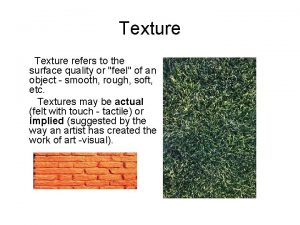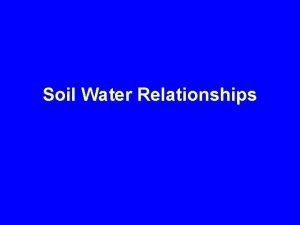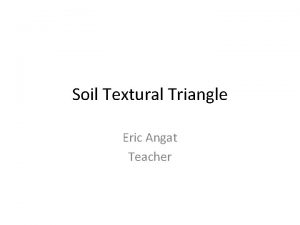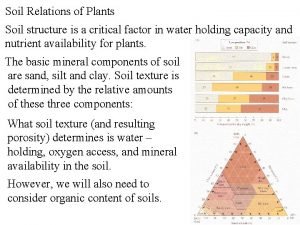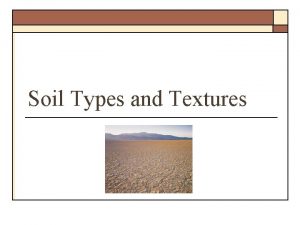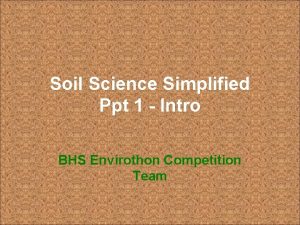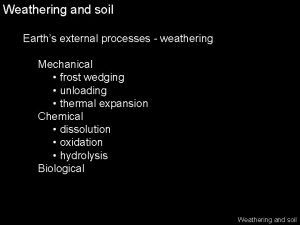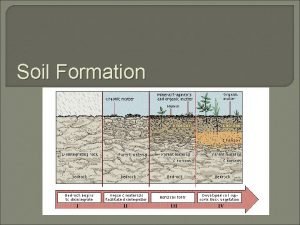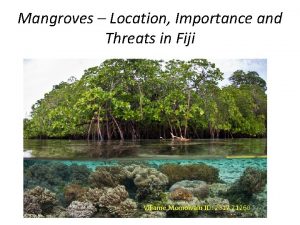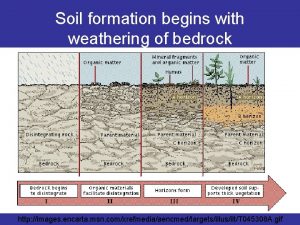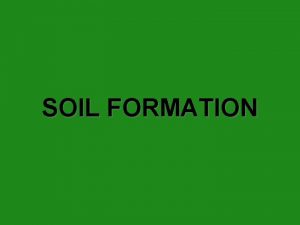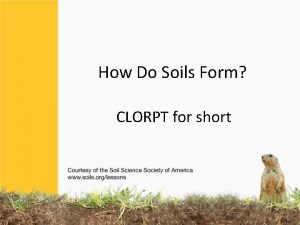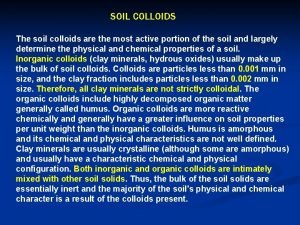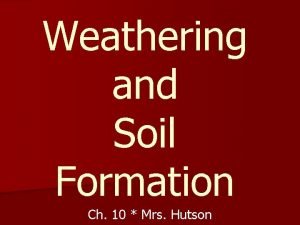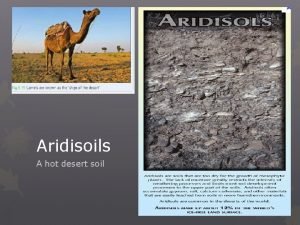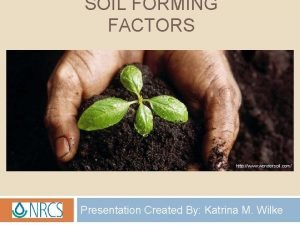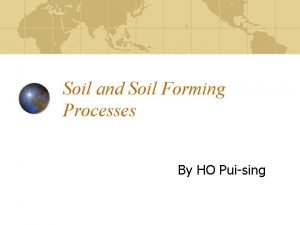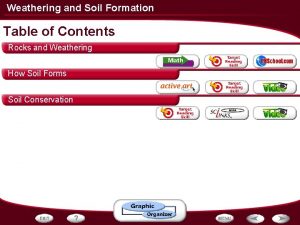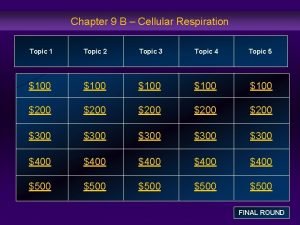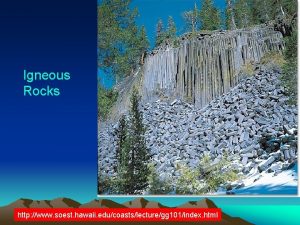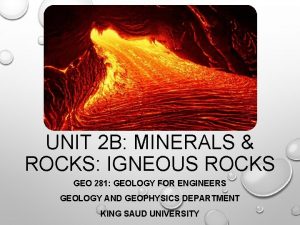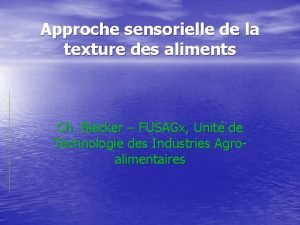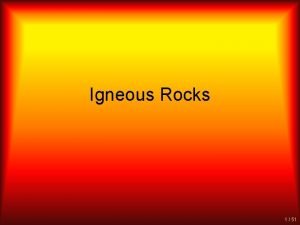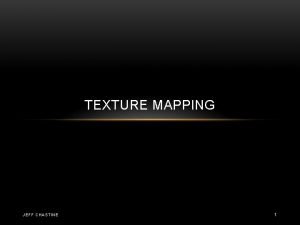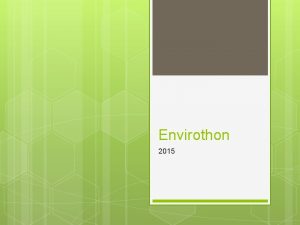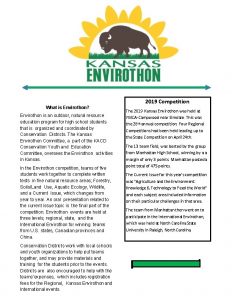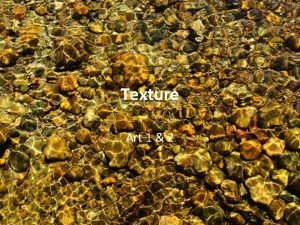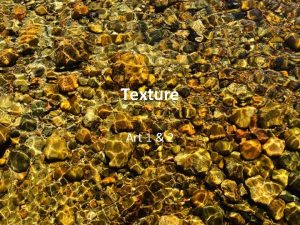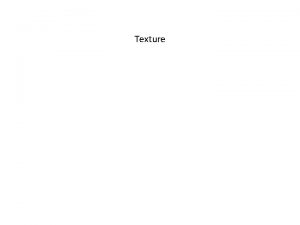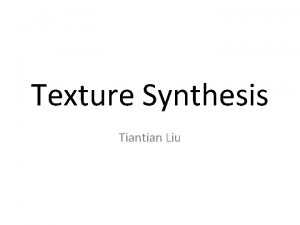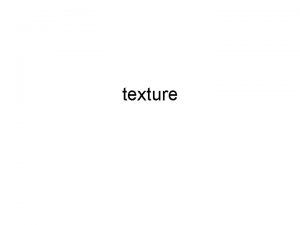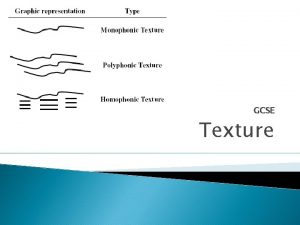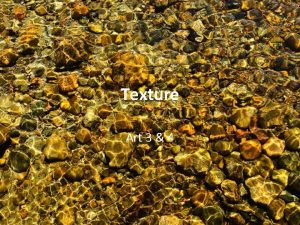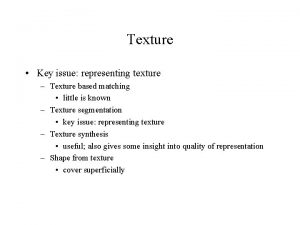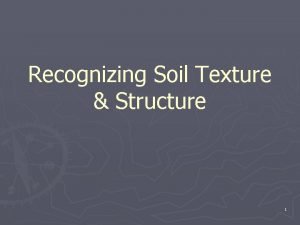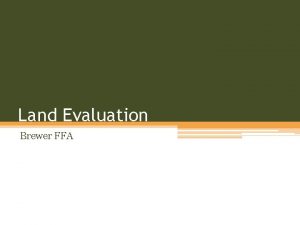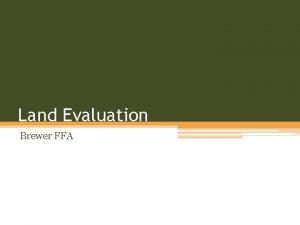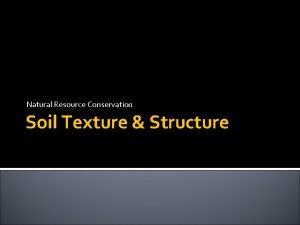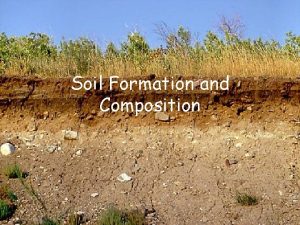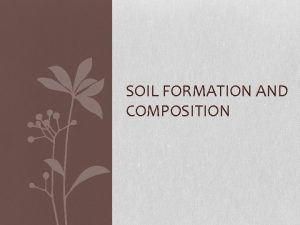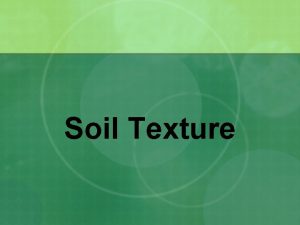Envirothon Soil Topics Soil Formation Soil Texture Soil






































- Slides: 38

Envirothon Soil

Topics • • • Soil Formation Soil Texture Soil Color Organic Matter p. H Salinity Soil Air Compaction/Shrink-Swell Drainage Erosion Soil Surveys

Typical Loamy Soil

Typical Clayey Soil

Typical Sandy Soil

Forming Factors • • • Climate Living Organisms Parent Material Topography Time

Climate • Most influential factor • Temperature and precipitation in particular • Determines the nature and speed of formation • High Heat, High humidity, abundant rain=a lot of power

Living Organisms • Plants and animals • Grasses vs trees • Microorganisms

Parent Material • Geology • Gulf Coast was a fluvial deltaic system • Soils are derived from loamy and clayey sediments • About 14, 000 years old

Topography • Nearly level • Slope occurs along drainage

Time • Soils on flood plains and coast line are youngest • Stable landscapes have older soils • Takes about 500 years to form an inch of soil from hard parent material

Texture • USDA • % of Sand, Silt and Clay • Key factor chemically and physically 100% Clay 10 90 20 80 30 70 40 60 Percent Clay Percent Silt 50 50 60 40 70 30 80 20 90 10 10 20 30 40 50 60 70 80 90 0% 10 nd Sa Percent Sand 0% Sil t 10

Clayey Soils • High Shrink-Swell • High Organic Content • High Water Holding Capacity • Agriculturally productive • Difficult to work with

Sandy Soil • • High pore space Low organic matter Low fertility Low water holding capacity • Easy to work with

Loamy Soil • Wide array of soils • Low to High Fertility • Low to High Organic content • Low to High Water Holding Content • Moderate to work with

Soil Color • Dark=high organic content • Light=low organic content • Red, yellow, brown is well drained • Gray could mean excessive wetness

Dark= High Organic • Most clayey soils in our area are dark and have high organic content

Light=Low organic content • <1 percent • Most loamy and sandy soils in our area are low in organic content

Well Drained • High on the landscape • Ridges and sloping areas • Yellow, red or brown • Black is usually well drained

Gray Could Be Wet • Gray surface • Contains mottles (oxidized or reduced iron) • Concave landscape • Wet soils could be associated with wetlands!

Organic Matter • Accumulation of partially decomposed plant and animal residues • Loosens soil • Nutrient source for plants • Increases water holding capacity • Food for microbes

Soil Organic Matter • Highest in the surface where the majority of biotic activity occurs • Important to stockpile surface layer • Easily destroyed when disturbed

Increasing Organic Content • Warm and humid conditions are ideal for microorganisms • Constant struggle • Leave grass clippings, leaves, and twigs • Add mulch

Organic Matter Considerations • • • Carbon to Nitrogen ratio Microbes use nitrogen to eat carbon Could cause nitrogen deficiency in plants Add nitrogen fertilizer Will correct over time Use good compost

Soil p. H • • • Ideal p. H range is 5. 5 to 7. 5 p. H >8. 5 could mean high salt content p. H<4 Aluminum and Iron toxicity p. H meters Add lime for soils less than 5. 5 and sulfur for soils above 7. 5 • Local soils are in good p. H range • Best to not get too worried about changing p. H

Salinity • A localized problem on Gulf Coast • Almost all soils have some salinity • Causes soil to become hard • Damages roots and stunts plants • Damages steel

Soil Air • Well aerated soils support better plant growth • Mechanical aerator • Incorporate organic matter into the soil for a long term solution

Soil Compaction • Occurs in high traffic areas • Occurs when soils are manipulated when wet • Plowing or incorporating organic matter decreases compaction • Minimize hazard of compaction by having a good thick layer of mulch on surface

Shrink and Swell • All clayey soils do it • Swell when wet and shrink when dry • $$$$$ to fix damage

Soil Drainage Classes • Very poorly Drained—Water is at or near the surface during much of the growing season • Poorly drained—The soil is wet at shallow depths periodically during the growing season or remains wet for long periods. • Somewhat Poorly drained—The soil is wet at a shallow depth for significant periods during the growing season. • Moderately Well drained—Water is removed from the soil somewhat slowly during some periods of the year • Well drained—Water is removed from the soil readily, but not rapidly. • Somewhat Excessively Drained—Water is removed from the soil rapidly. • Excessively Drained—Water is removed from the soil very rapidly.

Drainage • Poorly drained soils are gray with oxidized iron zones • Concave landscapes • Usually have water loving plants

Drainage • Well drained are brown, yellow or red and most black soils • Convex landscapes • Avoid making depressions if you want the soil to stay well drained

Erosion • Soil moved by wind or water • Occurs in high traffic areas where surface vegetation is gone • Areas with more than 3 percent slope are susceptible • Mulch and terraces (anything to slow wind and water down)

Soil Surveys • An inventory of soils that includes maps, interpretative tables, and soil descriptions for use in general land use planning

Using a Soil Survey • Locate your area of interest in the soil map section • Identify all of the soil map unit symbols at your area of interest

How to Use Soil Surveys • Go to the table that contain the information you seek • Find your map unit symbol and then find the land use practice • Table provides information on suitability for that soil for that particular land practice

References The Nature and Properties of Soils by N. C. Brady NRCS Soils https: //www. nrcs. usda. gov/wps/portal/nrcs/site/soils/home/ Natural Resources Conservation Service – Texas http: //www. nrcs. usda. gov/wps/portal/nrcs/site/tx/home/ Soil Data Access http: //sdmdataaccess. nrcs. usda. gov/ TAMU Department of Soil and Crop Sciences http: //soilcrop. tamu. edu

Contacts • USDA-Natural Resources Conservation Service – – Rosenberg: 281 -232 -6898 ext 3 Angleton: 979 -549 -0235 Temple State Soils Staff: 254 -742 -9850 Rosenberg Soil Survey Office: 281 -232 -4668 ext 124
 Implied texture
Implied texture Available water definition
Available water definition Apes soil lab answers
Apes soil lab answers Texture triangle
Texture triangle Soil texture water holding capacity
Soil texture water holding capacity What is the importance of soil
What is the importance of soil Forms of iron
Forms of iron Soil horizon ppt
Soil horizon ppt Formation initiale vs formation continue
Formation initiale vs formation continue Venn diagram of mechanical and chemical weathering
Venn diagram of mechanical and chemical weathering What are the four processes of soil formation
What are the four processes of soil formation Soil formation
Soil formation Formation of soil
Formation of soil Soil formation begins with weathering of
Soil formation begins with weathering of Soil textural triangle practice exercises
Soil textural triangle practice exercises Clorpt
Clorpt Talk dirty
Talk dirty Process of soil formation
Process of soil formation Types of soil colloids
Types of soil colloids Venn diagram of chemical and mechanical weathering
Venn diagram of chemical and mechanical weathering Hot desert soil
Hot desert soil How soil is formed
How soil is formed Factors affecting soil formation
Factors affecting soil formation Stages of soil development
Stages of soil development Convergent plate boundaries
Convergent plate boundaries Living soil vs dead soil
Living soil vs dead soil Music of classical period 1750 to 1820
Music of classical period 1750 to 1820 The air bubbles and spongy texture of bread
The air bubbles and spongy texture of bread Cudabindtexture
Cudabindtexture Rhythm in baroque music
Rhythm in baroque music Vista taskbar texture
Vista taskbar texture Marilyn series
Marilyn series Texture of rocks that have many pits from gas escape.
Texture of rocks that have many pits from gas escape. Igneous rock texture
Igneous rock texture Mazda texture analysis
Mazda texture analysis Analyseurs de texture des aliments
Analyseurs de texture des aliments Summed area table
Summed area table Type of igneous rocks
Type of igneous rocks Jeff chastine
Jeff chastine
